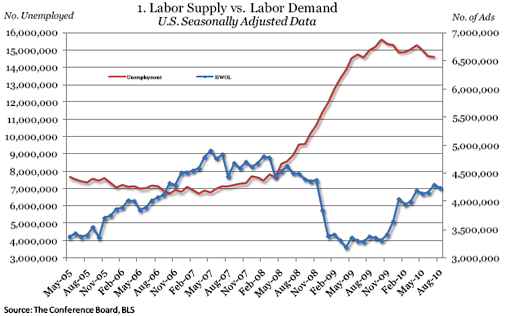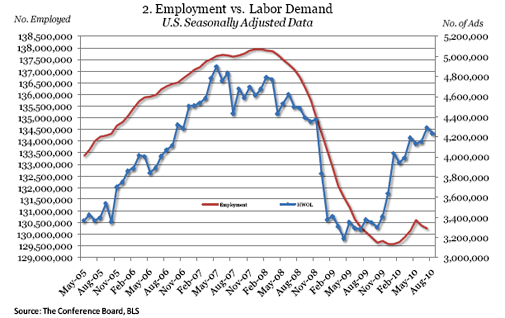- August picture mixed across the U.S. with moderate gains in Midwestern and Western States and dips in labor demand in the Northeast and South
- Demand for management workers as well as service workers in sales, food preparation and serving, and personal care continues to rise
Online advertised vacancies dropped 57,100 in August to 4,236,200, following an increase of 139,200 in July, according to The Conference Board Help Wanted OnLine™ (HWOL) Data Series released. The gap between the number of unemployed and advertised vacancies (supply/demand rate) stood at 3.40 unemployed for every advertised vacancy in July (the last available unemployment data) but is down from its peak of 4.73 in October 2009.
“Labor demand continues to struggle to post gains month after month,” said June Shelp, Vice President at The Conference Board. “During the last few months, gains in online job demand one month have been partially offset by dips in the following month. But the good news is that overall job demand is still maintaining a modest upward trend for both the nation and most States.”


REGIONAL AND STATE HIGHLIGHTS
- Moderate gains in Midwestern and Western States offset by declines in Northeast and South
The Midwest rose by a slim 5,800 in August after having risen 42,800 in July with several large states in the regions continuing to post gains. Illinois was up 2,900 in August after experiencing the largest gain in the region (16,800) in July and reached its highest level since June 2008. Minnesota rose just 800 to its highest level since October 2008. Michigan gained just 600 and continued up to its all-time highest level since the HWOL series began in May 2005. Ohio was up 300. Missouri dropped 900 in August after an increase of 6,300 in July. Wisconsin lost less this month (500) after having decreased 5,000 in July. Among the States with smaller populations, North Dakota gained 500 while Indiana gained 100.
In the West labor demand increased by 1,700. After experiencing a rise of 34,800 in July, California gained just 1,400 in August. Washington and Colorado experienced increases of 1,300 and 600 respectively. Colorado’s level is at its highest since November 2008. Arizona dipped by 700 after a July gain of 7,900. Among the smaller States, Nevada gained 2,200 and Hawaii and Alaska rose 800 while Oregon dropped 2,800 and New Mexico declined 200.
The Northeast region declined by 19,200 this month and more than offset its July gain of 12,900 and reflected a pullback in labor demand in all of the largest states in the region. New Jersey lost 8,100 after gaining 30,200 in the previous four months. After a 2-month gain of 30,600, New York dipped 3,000 in August. Massachusetts was down 1,500, and Pennsylvania edged down 400. Among the smaller States, Connecticut and Vermont declined 2,800 and 900 respectively. Maine and New Hampshire were down modestly by 400 and 300 respectively. Rhode Island gained 800.
Online advertised vacancies in the South declined in August by 14,000, reflecting drops in four out of the six large States. The largest decline occurred in Maryland (-5,700). Next was Virginia with a decrease of 3,200. North Carolina declined 2,300 after a 2-month gain of 17,800 while Georgia fell by 2,000 in August. Texas experienced a gain of 8,000, due largely to gains in sales and related occupations, healthcare practitioners and technical occupations, and management occupations. Florida gained 7,800 in August and, combined with its July gain, was up over 15,000 in the last two months. Florida’s August gain reflected increases in office and administrative support and computer and mathematical science positions. Among the less populous states in the South, advertised vacancies in Kentucky increased by 2,900, Louisiana increased by 2,400, and Oklahoma increased by 1,100.
The Supply/Demand rate for the U.S. in July (the latest month for which unemployment numbers are available) was at 3.40, indicating that there are just over 3 unemployed workers for every online advertised vacancy. Nationally, there are 10.3 million more unemployed workers than advertised vacancies. The number of advertised vacancies exceeded the number of unemployed in only North Dakota, where the Supply/Demand rate was .99. States with the next lowest rates include South Dakota (1.31), Alaska (1.38), and Nebraska (1.41), where the Supply/Demand rates reflected the fact that there was just over one unemployed for every online advertised vacancy. States with the highest Supply/Demand rates are Mississippi (6.63) and Michigan (6.50), where there are over 6 unemployed people for every advertised vacancy. Although still among the highest in the nation, Michigan’s S/D rate has improved significantly from the 10.2 in August 2009 when there were just over 10 unemployed for every online advertised vacancy. Other states where there are at least 5 unemployed for every advertised vacancy are Indiana (5.28) and Kentucky (5.00).
It should be noted that the Supply/Demand rate only provides a measure of relative tightness of the individual state labor markets and does not suggest that the occupations of the unemployed directly align with the occupations of the advertised vacancies.
OCCUPATIONAL HIGHLIGHTS
- Demand for Management workers rises 8,300 in August
- Demand for Healthcare Practitioners and Technical workers down by 31,500 in August
- Computer and Mathematical Science advertised vacancies drop 14,000
Among the top 10 occupation groups with the largest numbers of online advertised vacancies, Management occupations posted the largest August increase, up 8,300 to 588,800 and followed a gain of 40,200 in July. The August rise was largely due to increases in demand for financial managers (branch or department), sales managers, marketing managers, postsecondary education administrators, and human resources managers. Advertised vacancies in this field are at their highest level since January 2008. The ratio between the number of unemployed looking for work and advertised vacancies was slightly over one job-seeker for each advertised vacancy.
Labor demand for Healthcare Practitioners and Technical occupations dropped for the second month in a row; demand was down 31,500 in August to 542,500. The drop was largely due to decreases in advertised vacancies for family and general practitioners, physicians and surgeons, general internists, and obstetricians and gynecologists. Correspondingly, Healthcare Support also dropped for the second straight month by 2,900 to 108,900, mainly due to the slide in Occupational Therapist Assistants and Physical Therapist Assistants. There were 2.6 unemployed for every advertised vacancy in healthcare support.
Healthcare is a broad field, and the relative tightness of the labor market varies substantially from the higher-paying practitioner and technical jobs to the lower-paying support occupations. In July, the latest month for which unemployment data are available, advertised vacancies for healthcare practitioners or technical occupations outnumbered the unemployed looking for work in this field by over 2 to 1, and the average wage in these occupations is $33.51/hour. In sharp contrast, the average wage for healthcare support occupations is $12.84/hour and there were over 2 unemployed looking for work in the field for every advertised vacancy.
Computer and Mathematical Science occupations were down 14,000 to 572,700 in August, offsetting part of the July gain when demand rose by 31,800. The decrease was largely due to decreases in demand for computer security specialists. Demand for workers in this occupational category exceeds the number of unemployed looking for work by just over 3 to 1.
Occupations in Sales and Related and Food Preparation and Serving Related have seen steady increases in labor demand and rose by 4,100 and 2,800 respectively in August. Both occupation groups have been rising consistently since the beginning of 2010. This month there were significant increases in First-Line Supervisors/Managers of Retail Sales Workers and Retail Salespersons in Sales and Related occupations and First-Line Supervisors/ Managers of Food Preparation and Serving Workers and Waiters and Waitresses for Food Preparation and Serving Related occupations. Food Preparation and Serving Related has increased their number of vacancies from 96,700 in January 2010 to 114,100. The number of unemployed seeking work in this occupation however outnumbers the advertised job vacancies by 10 to 1, but this is an improvement from the beginning of the year where there were over 12 unemployed for every advertised vacancy. In Sales and Related occupations there were over 3 unemployed looking for work for every advertised vacancy in July.
Supply/Demand rates indicated that, among the occupations with the largest number of online advertised vacancies, there is a significant difference in the number of unemployed seeking positions in these occupations. Among the top ten occupations advertised online, there were more vacancies than unemployed people seeking positions for Computer and Mathematical Science (0.3), Healthcare Practitioners (0.4), and Architecture and Engineering (0.9). On the other hand, in Food Preparation and Serving-Related occupations, there were over 10 people seeking jobs in this field for every online advertised vacancy (10.4) and there were nearly eight unemployed looking for work in Transportation and Material Moving positions for every advertised opening (7.5).
METRO AREA HIGHLIGHTS
- Washington, D.C., Oklahoma City, and Baltimore have the lowest Supply/Demand rates
- Online advertised vacancies in all of the 52 largest metropolitan areas are above last year’s levels
In August, all of the 52 metropolitan areas for which data are reported separately posted over-the-year increases in the number of online advertised vacancies. Among the three metro areas with the largest numbers of advertised vacancies, the New York metro area was 32 percent above its August 2009 level, the Washington, D.C. metro area was 18 percent above its August 2009 level, and the Los Angeles metro area was 15 percent above last year’s level.
The number of unemployed exceeded the number of advertised vacancies in all of the 52 metro areas for which information is reported separately. Washington, D.C., Oklahoma City, and Baltimore were the locations with the most favorable supply/demand rates, where the number of unemployed looking for work was only slightly larger than the number of advertised vacancies. On the other hand, metro areas in which the respective number of unemployed is substantially above the number of online advertised vacancies include Riverside, CA –where there are over 10 unemployed people for every advertised vacancy (10.4) – Detroit (7.3), Miami (5.5), and Sacramento (5.0). Supply/Demand rate data are for June 2010, the latest month for which unemployment data for local areas are available.





